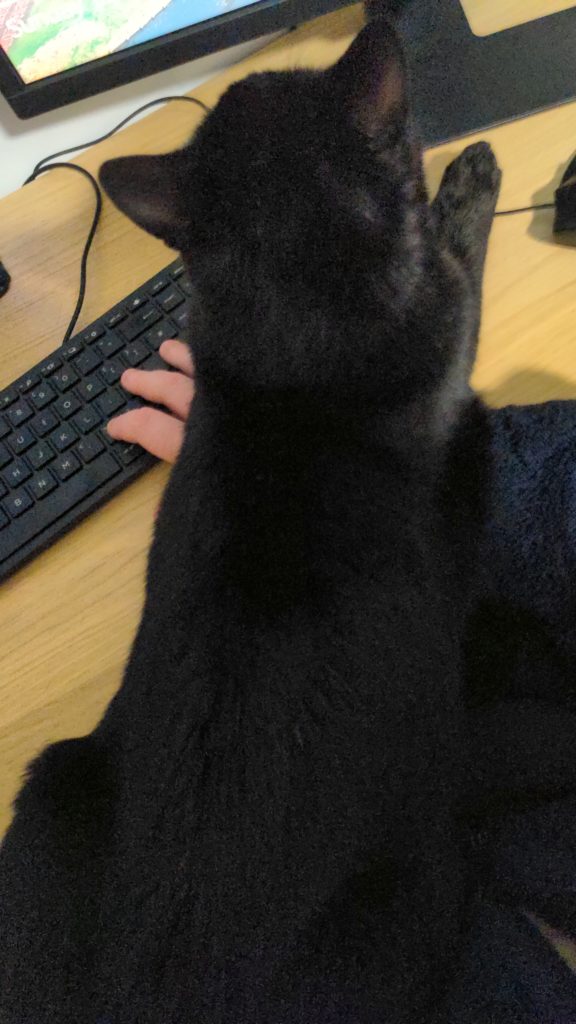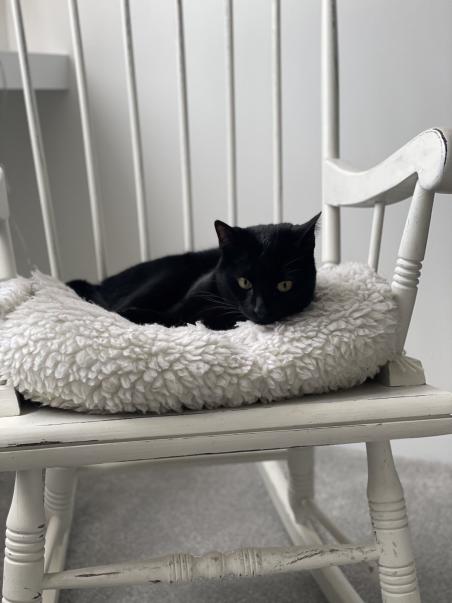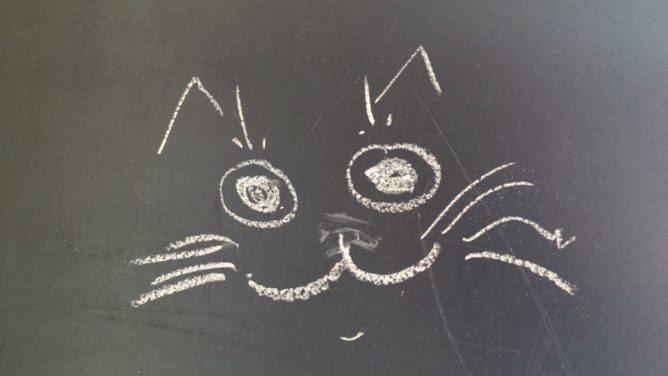- Here at Brologue HQ – this is just a post about the cat, isn’t it?
- Yes, yes it is. I figured I’d better do it sooner rather than later.
- Cats are more affectionate than we think. It’s all in the body language and appealing to the raw cat, to bring out the best version of themselves.
Here at Brologue, we take pride in our health and safety at work. We believe in feeding your workers and treating them as your equal as the foundations of a successful business. When the pandemic hit, when everyone was told they had to ‘stay at home,’ we knew what the ruling classes were really trying to tell us. Hunched over a laptop from 9 to 5 is no fun when all you’ve got to show for it is complaints about back pain no-one else can see. Workers the world over began to wonder, “How much does the boss know about what I’m doing right now, and does it pleasure them to know I have to justify my pointless job to others?”
We saw between the lines – it wasn’t staying at home. Except maybe for the first few weeks, when everyone started cordoning off what space they could to separate ‘work’ and ‘rest,’ building indoor gyms, and celebrities sang teary-eyed songs over Zoom. It was agreed (didn’t you get the memo?) that, for the first time in a few hundred years, everyone would start living at work again.
That’s why, at the apex of the COVID crisis, we took the initiative and established a world-first position to support our workers – the Boredom Officer (B.O.) – and justify their right to downtime at work. Their role is to mandate periods of rest during work hours; to comfort workers during periods of psychological distress; and to notify them of when they’ve worked enough hours for the day.
Here’s what working as a Boredom Officer looks like:


Alright, that’s enough pretense.
There comes a point where anyone who looks after a cat and has an Internet connection must share said cat with the world. I thought I’d get this post out sooner rather than later. This is Bo, and he’s the moggie that helps keep the blog rolling. I don’t share images of Bo with a lot of people, but those people tell me he’s very handsome. I couldn’t possibly say. All cats are beautiful and handsome, but mine is more beautiful and handsome than the rest.
There’s a Winston Churchill quote often mentioned on the perceived nature of cats: “Dogs look up to us. Cats look down on us. Pigs treat us as equals.” Cats are seen as aloof, manipulative, and uncaring. Cats see a human bringing them food in a goal and think they’re gods. Yes, in ancient Egypt, they were once revered for their pest control (grains were a vital staple food in ancient Egyptian society), to the point they would be mummified for the afterlife, and owners would shave their eyebrows in mourning. They were also bred to be slaughtered as a sacrifice to the gods. They’re often seen as ‘low-maintenance’ pets who can look after themselves outdoors; when Queen Victoria owned cats, Britain thought it trendy to bring them indoors; by the time arguments arose that it was cruel to keep a cat indoors, humans had already invented automobiles, and we’d continue to make them sleeker, faster, and deadlier.
To understand the nature of the cat, it’s better if one has a cat.
“But ah,” says the armchair pop psychologist, “should that not be, ‘belongs to‘ a cat?”
I don’t think so. I think what rubs folks the wrong way about cats is the possibility that they are our equals, and are unsure how to deal with that. A cat looks down on you because they’ve figured out that they can climb to the ceiling, and wants to know what’s up there.
Although domestic cats look and seem to behave like their closest cousins – European and African wildcats – researchers in recent decades have slowly pieced together the ways that cats have adapted to communicate, with us, and with other cats. One recent study of 53 adult cats living at the CatCafé Lounge in Los Angeles attempted to identify and classify different facial expressions in cats:
https://doi.org/10.1016/j.beproc.2023.104959
Contrary to popular belief, cats are sociable. It’s been known for some time that cats have developed body language for communication, and have several different kinds of vocal expressions which they explicitly direct towards their humans. As the Independent’s coverage of the study explains it, the researchers found that it’s all in the whiskers and mouth:
https://www.independent.co.uk/news/science/cats-facial-expressions-study-communication-b2438853.html
Over the course of 3+ hours’ worth of footage, the researchers recorded significant communication events between the cats. Through combinations of parted lips, pupil dilation/constriction, blinking, nose licking, curling the corners of the mouth, and ear movements, they could identify up to 276 distinct facial expressions. Whiskers, in particular, would make cats terrible poker players: if a cat’s content or happy, they almost always have their whiskers facing forwards. Most visually obvious are the whiskers on a cat’s face and head, but in addition, they have smaller sensory hairs all over their body.
As I was writing this, Bo woke up, and swaggered smoothly towards me. I put an open palm out a distance from him, scraped my middle and index fingers across my thumb to invite him for scritches. His tail immediately sprang upwards, swinging from ? to ! as cat tails do. He’s flourishing, focused, in his lane, in his territory, confident, and with his favourite person.
Oh God he’s on my desk now. My keyboard’s out. He’s sat like a loaf with his paw near the spacebar, so he can start editing if it fancies him.
He didn’t do any editing. Crisis averted. There was a TikTok trend a couple of years ago where people made miniature versions of their devices to get their cats to stop lying on them. That doesn’t work on Bo.
Ears are another excellent indication of how a cat is feeling. Ears facing forwards in a relaxed, neutral position (like in the image of Bo in the rocking chair) are one sign that a cat is relaxed. If they perk up in an upright position, they’re trying to focus on something or someone – like you. Their ears are really flexible, and can swivel almost 180 degrees. When you see them doing the ‘radar ears’ routine, it’s usually because there’s something unfamiliar in their territory that they want to assess – a guest, running water, a sizzling pan and so on. Cautious, but curious.
Then there’s the tail. Unlike dogs, who wag their tails when they’re happy, cats will flick the ends of their tails when they’re putting all their energy into focusing on something. If your cat has a good lookout to watch birds from, you’ll have noticed this whenever they fly overhead. At that point, they need to release that energy somewhere, so there’s no better time than to offer to play with them. On the other hand, if the whole tail is swishing vigorously, that could be a sign of irritation or overstimulation from the outside world, and thus it’s best to leave them be, and stop whatever’s causing the overstimulation, if you can.
But the number one, most essential cat body language trick everyone needs to know about is the slow blink. All cats – and I do mean, ALL cats, big and small – blink slowly and turn away as a sign of friendliness, non-aggression, and trust. You’re hardly going to tame a big cat this way, but for any house cat unfamiliar with you, this is like holding out an olive branch.
No two cats are alike, of course, and these are just some of the signals folks have managed to identify over the years. Socialising with a cat involves reading their body language, and being aware of your own so you don’t come off as a threat. You really can just have a conversation with a cat through slow blinks and turning away. If they turn their back on you, and or show you their butt, that’s a sign that they trust you.
https://old.reddit.com/r/coolguides/comments/ox76f3/a_guide_to_cat_body_language/
I can’t end a post on cats and cat behaviour without talking about Jackson Galaxy, a cat behaviourist, and his YouTube channel. He’s weel-kent in the States as the host of My Cat From Hell, which is essentially a reality TV series that gives you an intimate view of him at work, getting to the bottom of behavioural issues in his client’s cats.
https://www.youtube.com/channel/UCheL-cUqfzUB8dfM_rFOfDQ
There is no tiny mind control device here – Galaxy believes the root of most behavioural problems stem from some issue in or out of the house that is impacting the needs of the ‘Raw Cat.’ This could be as simple as a lack of stimulation, or a lookout that’s easy for other cats in the neighbourhood to trespass. When these issues are ameliorated, the cat’s aggression dissipates, they chill out, and you can start to see signs that the cat has got their ‘mojo’ back, like John Travolta in the opening scene of Saturday Night Fever.
Above all else, when we take care of a cat (or cats), we have to meet them halfway. Our house is as much our own territory as it is theirs. Bo, though a little skittish at times, has definitely been met halfway – beds in every room; dedicated climbing spots; and lots of toys and puzzle feeders to keep him stimulated. In return, I’ve got a cat who loves to see me whenever I come home, who’s not afraid to tell me it’s time to stop using technology by sitting on keyboards and slipping behind screens, and who gives me a lot of affection to get me through my day.
He’s my #1 B.O., and he smells good.
